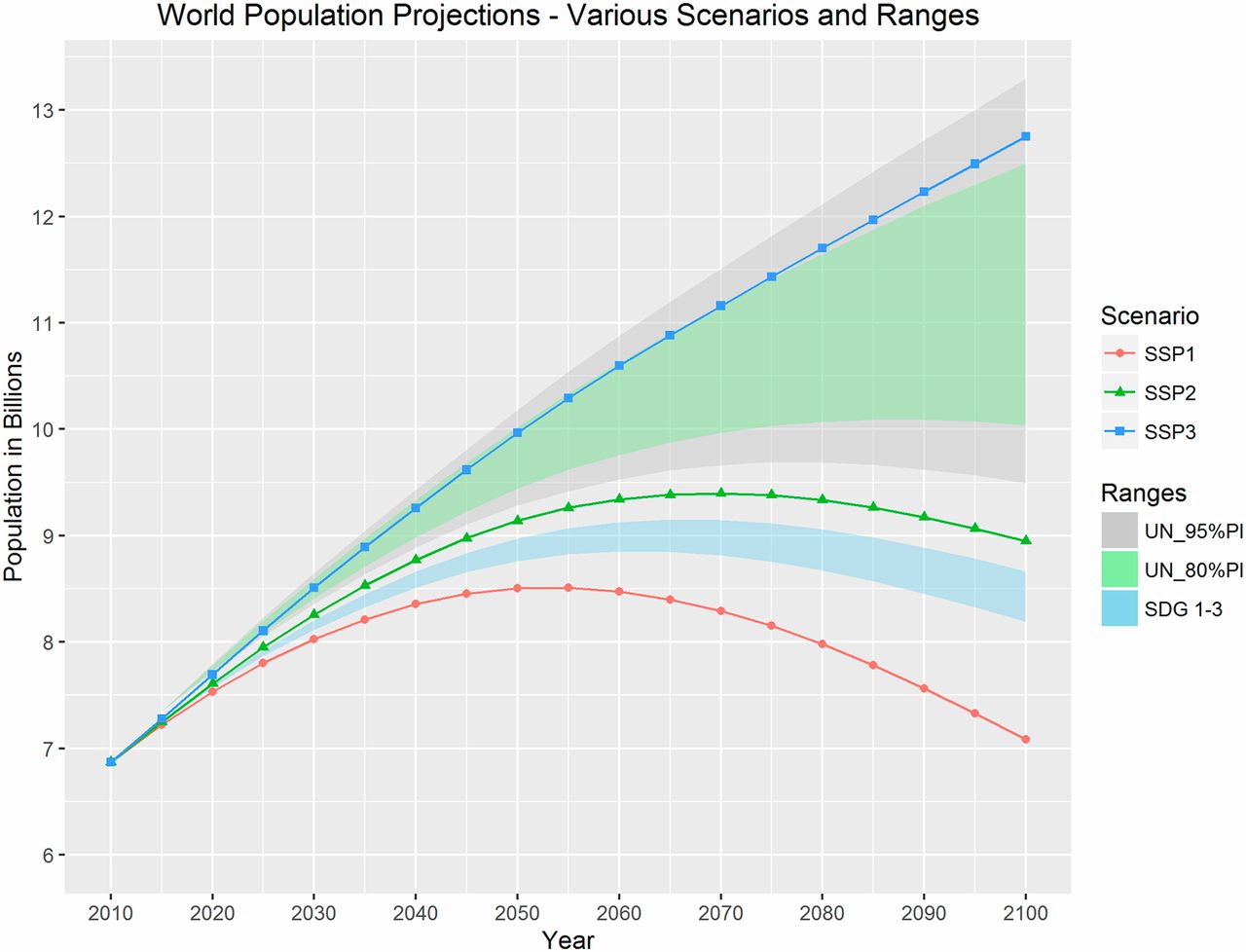In September 2015 the leaders of the world under the umbrella of the United Nations in New York subscribed to an ambitious set of global development goals, the Sustainable Development Goals (SDGs). If actually pursued, several of these targets, particularly in the fields of reproductive health and female education, will have strong direct and indirect effects on future population trends, mostly in the direction of lower population growth. In this paper we endeavor to translate the most relevant of these goals into SDG population scenarios and thus quantify the likely effects of meeting these development goals on national population trajectories. The results show that meeting these goals would result in the world population peaking around 2060 and reaching 8.2–8.7 billion by 2100, depending on the specific SDG scenario.
This analysis quantitatively demonstrates that demography is not destiny and that policies, particularly in the field of female education and reproductive health, can contribute greatly to reducing world population growth.

Meeting the Sustainable Development Goals leads to lower world population growth
by Guy J. Abel, Bilal Barakat, Samir KC and Wolfgang Lutz
PNAS
https://www.pnas.org/doi/10.1073/pnas.1611386113
Significance
The future of world population growth matters for future human well-being and interactions with the natural environment. We show the extent to which world population growth could be reduced by fully implementing the Sustainable Development Goals (SDGs) whose health and education targets have direct and indirect consequences on future mortality and fertility trends. Although this assessment is consistent with the Shared Socioeconomic Pathways scenarios used in the Intergovernmental Panel on Climate Change context, it is inconsistent with the prediction range of the United Nations projections for which we present sensitivity analyses and suggests that their range is likely too narrow. Given our assumptions, the SDGs have a sizable effect on global population growth, providing an additional rationale for vigorously pursuing their implementation.
Abstract
Here we show the extent to which the expected world population growth could be lowered by successfully implementing the recently agreed-upon Sustainable Development Goals (SDGs). The SDGs include specific quantitative targets on mortality, reproductive health, and education for all girls by 2030, measures that will directly and indirectly affect future demographic trends. Based on a multidimensional model of population dynamics that stratifies national populations by age, sex, and level of education with educational fertility and mortality differentials, we translate these goals into SDG population scenarios, resulting in population sizes between 8.2 and 8.7 billion in 2100. Because these results lie outside the 95% prediction range given by the 2015 United Nations probabilistic population projections, we complement the study with sensitivity analyses of these projections that suggest that those prediction intervals are too narrow because of uncertainty in baseline data, conservative assumptions on correlations, and the possibility of new policies influencing these trends. Although the analysis presented here rests on several assumptions about the implementation of the SDGs and the persistence of educational, fertility, and mortality differentials, it quantitatively illustrates the view that demography is not destiny and that policies can make a decisive difference. In particular, advances in female education and reproductive health can contribute greatly to reducing world population growth.
(Google Translate)
SDGs の達成は、世界の人口増加率の低下につながる (Guy J. Abel et al.)
2015 年 9 月、ニューヨークの国連の傘下にある世界の指導者たちは、野心的な一連の世界的な開発目標である持続可能な開発目標 (SDG) に同意しました。 これらの目標のいくつかは、特にリプロダクティブ ヘルスと女性教育の分野で実際に追求された場合、主に人口増加率の低下の方向で、将来の人口動向に直接的および間接的に強い影響を与えるでしょう。 この論文では、これらの目標の中で最も関連性の高いものを SDG の人口シナリオに変換し、これらの開発目標を達成することが国の人口の軌跡に及ぼす可能性のある影響を定量化するよう努めています。 結果は、これらの目標を達成すると、特定の SDG シナリオに応じて、世界人口が 2060 年頃にピークに達し、2100 年までに 82 億から 87 億に達することを示しています。
この分析は、人口動態は運命ではなく、特に女性教育とリプロダクティブ ヘルスの分野における政策が、世界人口の増加を抑えるのに大きく貢献できることを定量的に示しています。
**
持続可能な開発目標を達成すると、世界の人口増加率が低下する
Guy J. Abel、Bilal Barakat、Samir KC、Wolfgang Lutz 著
PNAS
https://www.pnas.org/doi/10.1073/pnas.1611386113
意義
世界の人口増加の将来は、将来の人間の幸福と自然環境との相互作用にとって重要です。 私たちは、健康と教育の目標が将来の死亡率と出生率の傾向に直接的および間接的な影響を与える持続可能な開発目標 (SDG) を完全に実施することによって、世界の人口増加をどの程度減らすことができるかを示します。 この評価は、気候変動に関する政府間パネルの文脈で使用されている共有社会経済経路シナリオと一致していますが、感度分析を提示する国連予測の予測範囲とは一致しておらず、その範囲が狭すぎる可能性が高いことを示唆しています。 私たちの仮定を考えると、SDG は世界の人口増加に大きな影響を与えており、その実施を精力的に追求する追加の理由を提供しています。
概要
ここでは、最近合意された持続可能な開発目標 (SDG) を成功裏に実施することで、予想される世界人口の増加をどの程度まで抑えることができるかを示します。 SDGs には、2030 年までにすべての女児の死亡率、リプロダクティブ ヘルス、および教育に関する具体的な定量的目標が含まれており、将来の人口動態の傾向に直接的および間接的に影響を与える指標です。 各国の人口を年齢、性別、および出生率と死亡率の差を含む教育レベルで層別化する人口動態の多次元モデルに基づいて、これらの目標を SDG の人口シナリオに変換し、2100 年の人口規模を 82 億から 87 億にします。 これらの結果は、2015 年の国連の確率論的人口予測によって与えられた 95% の予測範囲外にあります。ベースライン データの不確実性、相関に関する保守的な仮定のために、これらの予測間隔が狭すぎることを示唆するこれらの予測の感度分析で研究を補完します。 そして、これらの傾向に影響を与える新しい政策の可能性。 ここで示した分析は、SDG の実施と、教育、出生率、死亡率の格差の持続性に関するいくつかの仮定に基づいていますが、人口動態は運命ではなく、政策が決定的な違いを生む可能性があるという見解を定量的に示しています。 特に、女性教育とリプロダクティブ ヘルスの進歩は、世界の人口増加の抑制に大きく貢献する可能性があります。